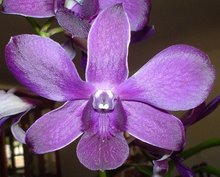The Greenhouse
The greenhouse (or GH) is a Rion Prestige 8.5'x16' greenhouse kit (see earlier posts for construction details).
This is the primary growing area for most of my orchids.
The greenhouse is at a North-South orientation, with the front of the greenhouse facing north. In colder climates, facing the doors north is a big no-no. But in the warmer Riverside climate this is not much of an issue.
Ventilation
I have two intake windows on the south end of the greenhouse, and both are controlled by temperature controlled vent openers. These pistons contain a resin that expands when the temperature rises, and contracts when the temperature drops. I have these windows roughly calibrated to be fully closed at 70F, and fully open at 80F.
I have three roof vents that are positioned at set intervals on the greenhouse roof. These roof vents are also controlled by similar vent openers as the intake windows. With the roof vents and intake windows, the greenhouse can have some level of passive ventilation as the hot air goes up the roof vents and draws cooler air through the intake windows.
During the Riverside summers though, passive ventilation is not enough.
Here is a picture of the south-west roof vent. The misting system in the picture is an old kit and has since been replaced.

I have a 16" 2000CFM exhaust fan mounted on the north side of the greenhouse. This side receives the least wind compared to the other three directions, so it gets the least resistance when the exhaust fan tries to remove the warm air from inside the greenhouse.
This exhaust fan is hooked up to an inline thermostat that I have calibrated to activate at 75F. Obviously this exhaust fan sees a lot of action during the summer months.
HAF (Horizontal Airflow Fans) - I have the following fans set up for proper air distribution inside the greenhouse:
* One 12" electric fan hung from the roof at the south end of the greenhouse.
* Two 6" oscillating desk fans placed on a shelf, about 3 feet apart along the eastern wall of the greenhouse.
This is the 12" fan on the southern end:

Shading - I use the following materials to reduce the sunlight entering the greenhouse:
* Aluminet 60% shade on the exterior of the greenhouse. It covers the entire roof, the west and east walls.
* Cut sections of generic 50% shade fabric (green) placed on the interior roof and walls of the greenhouse to provide additional shade to plants as necessary.
Misting System - I have set up a misting system to provide additional cooling to the greenhouse during the hot summer months. The idea behind the misting system is that the tiny water droplets exiting the nozzles quickly evaporate and thus reducing the air temperature temporarily.
The misting line has 18 low-flow brass mist nozzles distributed throughout the greenhouse interior.
I have the misting line hooked up to a programmable watering timer, that is set up to activate for 1 minute every 30 minutes. This misting cycle runs from 10:00AM through 5:00PM during the hot summer months. I then cut down on the misting schedule as the season gets cooler. The misters are completely off by November through March.
The misting line is also hooked up to an inline polyphosphate filter to reduce the calcium contents of the water and minimize calcium deposits on the plants' leaves.
This misting system is used exclusively for cooling purposes, and not for irrigation.
*Note: The old misting kit was a 6-nozzle kit, and requires 10 minutes per run to reach the desired temperature and humidity levels inside the greenhouse.
The new 18-nozzle misting kit allows me to reach the desired levels within 1 minute.
Heating - Believe it or not, I need to heat the greenhouse during the winter. Granted that we dont get several feet of snow (we rarely get snow actually), the winter temperatures are still cold enough to kill most unprotected orchids.
I use an electric oil heater that is rated for rooms up to 400 square feet. This heater keeps the interior temperatures above 50F (Although I have been advised recently that I should keep it above 60F. I will be attempting that this winter).
This is the heater that I use:



1 comment:
I like it: you leave nothing to chance!
Post a Comment